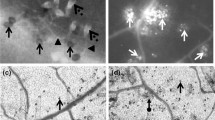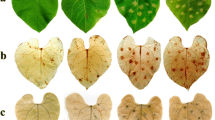Abstract
Erwinia amylovora is a necrogenic bacterium, causing the fire blight disease on many rosaceous plants. Triggering oxidative burst by E. amylovora is a key response by which host plants try to restrain pathogen spread. Electron transport chain (ETC) of chloroplasts is known as an inducible source of reactive oxygen species generation in various stresses. This research was performed to assess the role of this ETC in E. amylovora–host interaction using several inhibitors of this chain in susceptible and resistant apple and pear genotypes. All ETC inhibitors delayed appearance of disease necrosis, but the effects of methyl viologen, glutaraldehyde, and DCMU were more significant. In the absence of inhibitors, resistant genotypes showed an earlier and severe H2O2 generation and early suppression of redox dependent, psbA gene. The effects of inhibitors were corresponding to the redox potential of ETC inhibitory sites. In addition, delayed necrosis appearance was associated with the decreased disease severity and delayed H2O2 generation. These results provide evidences for the involvement of this ETC in host oxidative burst and suggest that chloroplast ETC has significant role in E. amylovora–host interaction.









Similar content being viewed by others
References
Abdollahi H, Ruzzi M, Rugini E, Muleo R (2004) An in vitro system for studying the interaction between Erwinia amylovora and genotypes of pear. Plant Cell Tissue Org Cult 79:203–212
Awais Khan M, Zhao YF, Korban SS (2011) Molecular mechanisms of pathogenesis and resistance to the bacterial pathogen Erwinia amylovora, causal agent of fire blight disease in Rosaceae. Plant Mol Biol Rep 30:247–260
Baker CJ, Orlandi EW, Mock NM (1993) Harpin, an elicitor of the hypersensitive response in tobacco caused by Erwinia amylovora, elicits active oxygen production in suspension cells. Plant Physiol 102:1341–1344
Barr R, Crane FL (2005) Inhibition or inactivation of higher plant chloroplast electron transport. In: Pessarakli M (ed) Handbook of photosynthesis. CRC Press, Boca Raton, pp 149–168
Bauer DW, Beer SV (1991) Further characterization of an hrp gene cluster of Erwinia amylovora. Mol Plant Microbe Interact 5:493–499
Bhattacharjee S (2011) Sites of generation and physicochemical basis of formation of reactive oxygen species in plant cell. In: Dutta Gupta S (ed) Reactive oxygen species and antioxidants in higher plants. CRC Press, Boca Raton, pp 1–30
Bocsanczy AM, Nissinen RM, Oh CS, Beer SV (2008) HrpN of Erwinia amylovora functions in the translocation of DspA/E into plant cells. Mol Plant Pathol 9:425–434
Bonasera JM, Kim JF, Beer SV (2006a) PR genes of apple: identification and expression in response to elicitors and inoculation with Erwinia amylovora. BMC Plant Biol 6:23
Bonasera JM, Meng X, Beer SV, Owens T, Kim WS (2006b) Interaction of DspE/A, a pathogenicity/avirulence protein of Erwinia amylovora, with pre-ferredoxin from apple and its relationship to photosynthetic efficiency. Acta Hortic 704:473–477
Bonn WG, van der Zwet T (2001) Distribution and economic importance of fire blight. In: Vanneste JL (ed) Fire blight, the disease and its causative agent, Erwinia amylovora. CABI Publishing, Walligford, pp 37–53
Buchanan BB, Balmer Y (2005) Redox regulation: a broadening horizon. Annu Rev Plant Biol 56:187–220
Chamnongpol S, Willekens H, Moeder W, Langebartels C, Sandermann JH, Van Montagu M, Inze D, Van Camp D (1998) Defense activation and enhanced pathogen tolerance induced by H2O2 in transgenic tobacco. Proc Natl Acad Sci USA 95:5818–5823
Corpet F (1988) Multiple sequence alignment with hierarchical clustering. Nucleic Acids Res 16:10881–10890
Dat J, Vandenabeele S, Vranova E, Van Montagu M, Inze D, Van Breusegem F (2000) Dual action of the active oxygen species during plant stress responses. Cell Mol Life Sci 57:779–795
DebRoy S, Thilmony R, Kwack YB, Nomura K, He SY (2004) A family of conserved bacterial effectors inhibits salicylic acid-mediated basal immunity and promotes disease necrosis in plants. Proc Nat Acad Sci USA 101:9927–9932
Eastgate JA (2000) Erwinia amylovora: the molecular basis of fire blight disease. Mol Plant Pathol 6:325–329
Eden-Green SJ, Billing E (1974) Fire blight. Rev Plant Pathol 53:353–365
Fuentes G, Talavera C, Oropeza C, Desjardins Y, Santamaria JM (2005) Exogenous sucrose can decrease in vitro photosynthesis but improve field survival and growth of coconut (Cocos nucifera L.) in vitro plantlets. In Vitro Cell Dev Biol Plant 41:69–76
Garmier M, Dutilleul C, Chetrit P, Boccara M, De Paepe R (2002) Changes in antioxidant expression and harpin-induced hypersensitive response in a Nicotiana sylvestris mitochondrial mutant. Plant Physiol Biochem 40:561–566
Gleason C, Huang SB, Thatcher LF, Foley RC, Anderson CR, Carroll AJ, Millar AH, Singh KB (2011) Mitochondrial complex II has a key role in mitochondrial-derived reactive oxygen species influence on plant stress gene regulation and defense. Proc Natl Acad Sci USA 108:10768–10773
Hardt H, Kok B (1977) Plastocyanin as the possible site of photosynthetic electron transport inhibition by glutaraldehyde. Plant Physiol 60:225–229
Hatzios KK, Penner D, Bell D (1980) Inhibition of photosynthetic electron transport in isolated spinach chloroplasts by two 1,3,4-thiadiazolyl derivatives. Plant Physiol 65:319–325
Heldt HW (2005) Plant biochemistry. Elsevier Academic Press, Burlington
Kim JF, Beer SV (2000) hrp Genes and harpins of Erwinia amylovora: a decade of discovery. In: Vanneste JL (ed) The disease and its causative agent, Erwinia amylovora. CABI Publishing, Walligford, pp 141–161
Kim JF, Wei ZM, Beer SV (1997) The hrpA and hrpC operons of Erwinia amylovora encode components of a type III pathway that secretes harpin. J Bacteriol 179:1690–1697
Kovács L, Wiessner W, Kis M, Nagy F, Mende D, Demeter S (2000) Short- and long-term redox regulation of photosynthetic light energy distribution and photosystem stoichiometry by acetate metabolism in the green alga, Chlamydobotrys stellata. Photosynth Res 65:231–247
Kovalchuk I (2011) Multiple roles of radicals in plants. In: Dutta Gupta S (ed) Reactive oxygen species and antioxidants in higher plants. CRC Press, Enfield, pp 31–44
Leblay C, Chevreau E, Robin LM (1991) Adventitious shoot regeneration from in vitro leaves of several pear cultivar (Pyrus communis L.). Plant Cell Tiss Org Cult 25:99–105
Li H, Sherman LA (2000) A redox-responsive regulator of photosynthesis gene expression in the Cyanobacterium synechocystis sp. strain pcc 6803. J Bacteriol 182:4268–4277
Lopez RG, Howell GS, Petrie SR (2004) Photosynthetic inhibition of ‘Seyval blanc’ grapevines with terbacil. Acta Hortic 640:155–161
Martin RE, Thomas DJ, Tucker DE, Herbert SK (1997) The effects of photooxidative stress on photosystem I measured in vivo in Chlamydomonas. Plant Cell Environ 20:1451–1461
Møller IM (2001) Plant mitochondria and oxidative stress: electron transport, NADPH turnover, and metabolism of reactive oxygen species. Annu Rev Plant Physiol Plant Mol Biol 52:561–591
Oh CS, Beer SV (2005) Molecular genetics of Erwinia amylovora involved in the development of fire blight. FEMS Microb Lett 253:185–192
Oh CS, Kim JF, Beer SV (2005) The Hrp pathogenicity island of Erwinia amylovora and identification of three novel genes required for systemic infection. Mol Plant Pathol 6:125–138
Oh CS, Carpenter SCD, Hayes ML, Beer SV (2010) Secretion and translocation signals and DspB/F-binding domains in the type III effector DspA/E of Erwinia amylovora. Microbiol 156:1211–1220
Oswald O, Martin T, Dominy PJ, Graham IA (2001) Plastid redox state and sugars: interactive regulators of nuclear-encoded photosynthetic gene expression. Proc Natl Acad Sci USA 98:2047–2052
Pike SM, Adam AL, Pu XA, Hoyos ME, Laby R, Beer SV, Novacky A (1998) Effects of Erwinia amylovora harpin on tobacco leaf cell membranes are related to leaf necrosis and electrolyte leakage are distinct from perturbation caused by inoculation of E. amylovora. Physiol Mol Plant Pathol 53:39–60
Popham PL, Pike SM, Novacky A (1995) The effects of harpin from Erwinia amylovora on the plasmalemma of suspension-cultured tobacco cells. Physiol Plant Pathol 47:39–50
Reboutier D, Frankart C, Briand J, Biligui B, Laroche S, Rona JP, Barny MA, Bouteau F (2007) The HrpN(ea) harpin from Erwinia amylovora triggers differential responses on the non-host Arabidopsis thaliana cells and on the host apple cells. Mol Plant Microbe Interact 20:94–100
Sharma P, Jha AB, Dubey RS, Pessarakli M (2012) Reactive oxygen species, oxidative damage, and antioxidative defense mechanism in plants under stressful conditions. J Botany 2012:1–26
Sippola K, Aro EM (1999) Thiol redox state regulates expression of psbA genes in Synechococcus sp. PCC 7942. Plant Mol Biol 41:425–433
Thordal-Christensen H, Zhang Z, Wie Y, Collinge DB (1997) Subcellular localization of H2O2 in plants, accumulation in papillae and hypersensitive response during the barley-powdery mildew interaction. Plant J 11:1187–1194
Triplett LR, Wedemeyer WJ, Sundin GW (2010) Homology-based modeling of the Erwinia amylovora type III secretion chaperone DspF used to identify amino acids required for virulence and interaction with the effector DspE. Res Microbiol 161:613–618
Tullberg A, Alexciev K, Pfannschmidt T, Allen JF (2000) Photosynthetic electron flow regulates transcription of the psaB gene in pea (Pisum sativum L.) chloroplasts through the redox state of the plastoquinone pool. Plant Cell Physiol 41:1045–1054
van der Zwet T, Beer SV (1999) Fire blight, its nature, prevention and control: a practical guide to integrated disease management. US Dept Agr, Washington, DC
Vanneste JL (1995) Erwinia amylovora. In: Singh US, Singh RP, Kohmoto K (eds) Pathogenesis and host specificity in plant diseases: histopathological, biochemical, genetic and molecular bases. Pergamon Press, Oxford, pp 21–46
Venisse JS, Guller G, Brisset MN (2001) Evidence for the involvement of an oxidative stress in the initiation of infection of pear by Erwinia amylovora. Plant Physiol 125:2164–2172
Venisse JS, Malony M, Faize M, Paulin JP, Brisset MN (2002) Modulation of defense responses of Malus spp. during compatible and incompatible interactions with Erwinia amylovora. Mol Plant Microbe Interact 15:1204–1212
Venisse JS, Barny MA, Paulin JP, Brisset MN (2003) Involvement of three pathogenicity factors of Erwinia amylovora in the oxidative stress associated with compatible interaction in pear. FEBS Lett 537:198–202
Wei ZM, Beer SV (1993) HrpI of Erwinia amylovora functions in secretion of harpin and is a member of a new protein family. J Bacteriol 175:7958–7967
Wei ZM, Sneath BJ, Beer SV (1992) Expression of Erwinia amylovora hrp gene in response to environmental stimuli. J Bacteriol 174:1875–1882
Xie Z, Chen Z (2000) Harpin-induced hypersensitive cell death is associated with altered mitochondrial function in tobacco cells. Mol Plant Microbe Interact 13:183–190
Yabuta Y, Mieda T, Rapolu M, Nakamura A, Motoki T et al (2007) Light regulation of ascorbate biosynthesis is dependent on the photosynthetic electron transport chain but independent of sugars in Arabidopsis. J Exp Bot 58:2661–2671
Zhao YF, Blumer SE, Sundin GW (2005) Identification of Erwinia amylovora genes induced during infection of immature pear tissue. J Bacteriol 187:8088–8103
Acknowledgments
This research was a collaboration project between Iranian Ministry of Agriculture, Seed and Plant Improvement Institute (SPII) and Azad University of Tehran, Science and Research Unit. The authors sincerely thank all technical stuff of fruit tissue culture and biotechnology laboratory of SPII for their kind supports.
Author information
Authors and Affiliations
Corresponding author
Rights and permissions
About this article
Cite this article
Abdollahi, H., Ghahremani, Z., Erfaninia, K. et al. Role of electron transport chain of chloroplasts in oxidative burst of interaction between Erwinia amylovora and host cells. Photosynth Res 124, 231–242 (2015). https://doi.org/10.1007/s11120-015-0127-8
Received:
Accepted:
Published:
Issue Date:
DOI: https://doi.org/10.1007/s11120-015-0127-8




